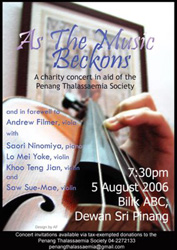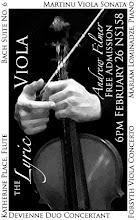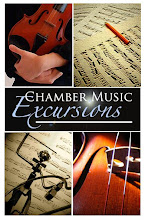This is a posting about recognizing intervals. This can be used in two ways:
a) To form an accurate idea of playing in tune - while chromatic tuners help to tell you whether one note is exactly correct, it is perhaps more important to be correct in the intervals, moving the right distance from one note to another.
b) To play by ear - that is, to be able to play a melody from listening to another player or a recording, without having the written music (notes).
To recognize intervals, there are at least three ways:
i) Listening to and remembering certain famous melodies that show a certain interval
ii) Using a scale to "count" the space of a certain interval
iii) Using chords and feeling choral progressions and cadences
We will discuss the first one today.
Melodies and Intervals
I cannot place mp3s about this here because of copyright laws, but I hope that we can share recordings with each other to help us think about these melodies.
Important:
I) Do not be shy to SING. Playing the violin can make you think what you play is right, rather than making sure what is right is what you play.
II) Here I will place the main intervals, there are more than this, but this is a good start, I hope. There are many tunes which use all these intervals; I have chosen the ones which have the intervals repeated a few times.
III) Do not play the violin with the recordings because the instruments there are probably tuned slightly differently to yours (or it has changed through the recording process), or are in a different key - just listen, and think about remembering the intervals. Then play your open string or starting note, and sing the melody in that key.
Minor second (one semitone, re flat): this interval is very important, because it is the basis of the chromatic scale, but is not part of a major or minor scale (which is weird, since it is called a "minor" second)
1) theme from the movie Jaws, played on double bass.
2) theme from The Pink Panther (now known more more its music than the original cartoon and comics)
Major second (one tone, re): this is also very important, since Western-based scales are made up of tones and semitones.
Second theme from the opening title music of Star Wars (any episode): see below
Major third (mi): part of a very basic chord - the tonic triad of a major key, so usually the tunes used are connected to the perfect fifth in do-mi-so
1) Bach's second violin concerto in E-major (first movement)
2) Beethoven's Fifth Symphony (LAST movement)
Perfect fourth (fa)
1) Eine Kleine Nachtmuzik (I really hope I got the spelling right): first movement
2) Star Wars, main theme (after the 6-8 second introduction): see below
Perfect fifth (so)
Lalo, Symphonie Espagnole for violin and orchestra (first movement)
Major sixth (la)
Tchaikovsky, Violin Concerto in D (first movement, main theme)
Major seventh (ti)
This one is difficult, because it is hard to find a piece which goes from do to ti. This is the leading note though, just one step (semitone) back to do.
The best example of do re mi fa so la ti do is still the Sound of Music.
Thursday, June 09, 2005
Subscribe to:
Post Comments (Atom)






1 comment:
พื้นฐานเรื่องความไม่เพี้ยนของเสียง
ต่อไปนี้จะกล่าวถึงวิธีการจดจำช่วงเสียงซึ่งจะนำไปใช้ประโยชน์ได้สองวิธี
a) เพื่อเป็นพื้นฐานในการเล่นไม่เพื้ยน – ในขณะที่เครื่องตั้งเสียงสามารถบอกว่าโน้ตตัวนั้นๆ เพี้ยนจากความถี่ที่ควรจะเป็นหรือไม่ จริงๆแล้วเราควรใส่ใจในเรื่องระยะของช่วงเสียงมากกว่า นั้นคือระยะช่วงเสียงระหว่างโน้ตตัวนึงไปยังอีกตัวนึง
b) เพื่อการเล่นโดยไม่ต้องมีโน้ตเพลง – คือสามารถเล่นเพลงใดๆ ได้จากการฟังหรือจากที่จำได้ โดยไม่ต้องมีโน้ตเพลง
การจดจำช่วงเสียงมีอย่างน้อย 3 วิธีดังนี้
i) จำจากเพลงท่อนที่เราคุ้นหู
ii) ไล่นับจากสเกล (Scale)
iii) ใช้คอร์ด (Chords) โดยการ “รู้สึก” ถึงการเปลี่ยนแปลงไปของคอร์ด
ในวันนี้เราจะพูดถึงวิธีแรกกัน
การจดจำช่วงเสียงจากเพลงที่เราคุ้นหู
ผมไม่สามารถโพสท์ mp3 เพลงที่เป็นตัวอย่างได้เพราะติดปัญหาเรื่องลิขสิทธิ์แต่หวังว่าพวกเราคงจะมีเพลงเหล่านี้กันบ้าง ลองเอามาแบ่งปันกันฟังนะครับ
สิ่งสำคัญคือ:
I) ควรร้องออกมา อย่าอาย
II) ที่จะกล่าวต่อไปนี้เป็นช่วงเสียงหลักๆ ซึ่งจริงๆแล้วมีมากกว่านี้ แต่การเริ่มต้นเอาเพียงที่สำคัญๆ ก่อน ท่อนเพลงที่คุ้นหูที่ควรเลือกใช้ก็ควรเป็นท่อนที่มีการเล่นซ้ำในช่วงเสียงนั้นหลายๆ ครั้ง
III) อย่าเล่นเครื่องดนตรีของคุณไปพร้อมกับ CD หรือ MP3 เนื่องจากการตั้งเสียงของเครื่องดนตรีใน CD เหล่านั้นอาจไม่ตรงตามเครื่องของคุณ (ในการเล่นเพลงบางยุคจะมีการตั้งเสียงให้สูงหรือต่ำกว่าปกติ)
Minor second (ครึ่งเสียงจากตัวโด, เร แฟลท) อันนี้เป็นช่วงเสียงที่สำคัญเพราะเป็นพื้นฐานของสเกลแบบครึ่งเสียง (Chromatic Scale) หมายเหตุ คำว่า Minor ในที่นี้ไม่ได้เกี่ยวข้องกับ Scale ที่เป็น Minor นะครับ ตัวอย่างท่อนเพลงดังๆ ที่ใช้ช่วงเสียงนี้คือ
1) ท่อนหลักจากหนังเรื่อง Jaws, ที่ใช้ Double Bass เช่น
2) ท่อนหลักจากการ์ตูนพิงค์แพนเตอร์
Major second (1 ช่วงเสียงจากตัวโด, โน้ตตัวเร) เป็นช่วงเสียงที่สำคัญ เพราะเป็นพื้นฐานของสเกลโดยทั่วไป ตัวอย่างท่อนเพลงดังๆ ที่ใช้ช่วงเสียงนี้คือ ท่อนที่ 2 จากเพลงเปิดหนังเรื่อง Star Wars
Major third (2 ช่วงเสียงจากตัวโด, โน้ตตัวมี) เป็นโน้ตสำคัญของคอร์ดประเภท Major เราเรียกว่าเป็น tonic triad โน้ตตัวนี้เป็นตัวเชื่อมไปสู่โน้ตสำคัญตัวต่อไปของคอร์ด (ตัวที่ 5 หรือเรียก perfect fifth) เช่น คอร์ด C Major ประกอบด้วยโน้ตพื้นฐาน 3 ตัว
โด (โน้ตพื้นฐานคอร์ด) – มี (Major third หรือ tonic triad) – ซอล (perfect fifth)
ตัวอย่างท่อนเพลงดังๆ ที่ใช้ช่วงเสียงนี้คือ
1) Violin Concerto หมายเลข 2 ของ Bach (บันไดเสียง E major) ท่อนแรก
2) Symphony หมายเลข 5 ของ Beethoven ท่อนสุดท้าย
Perfect forth (2.5 ช่วงเสียงจากตัวโด, โน้ตตัวฟา) ตัวอย่างท่อนเพลงดังๆ ที่ใช้ช่วงเสียงนี้คือ
1) Eine Kleine Nachtmuzik ท่อนแรก (ไม่แน่ใจว่าสะกดถูกหรือเปล่า)
2) Star Wars ท่อนหลัก (ช่วง 6-8 วินาทีหลังจากเริ่ม)
Perfect Fifth (3.5 ช่วงเสียงจากตัวโด, โน้ตตัวซอล) ตัวอย่างท่อนเพลงดังๆ ที่ใช้ช่วงเสียงนี้คือ Symphonie Espagnole ของ Lalo ท่อนแรก
Major Sixth (4.5 ช่วงเสียงจากตัวโด, โน้ตตัวลา) ตัวอย่างท่อนเพลงดังๆ ที่ใช้ช่วงเสียงนี้คือ Violin Concerto ของ Tchaikovsky ท่อนหลักใน movement ที่ 1
Major Seventh (5.5 ช่วงเสียงจากตัวโด, โน้ตตัวที) อันนี้ค่อนข้างยากที่จะหาตัวอย่างเพลงที่ใช้ช่วงเสียงนี้ (โด –> ที) เพราะเป็นโน้ตนำที่จะกลับไปสู่ตัว โด เหมือนเดิม
ตัวอย่างที่ทีที่สุดของ โด – เร – มี – ฟา – ซอล – ลา – ที – โด ยังคงเป็นเพลง Sound of Music เช่นเดิม อีกเพลงนึงที่ใช้ได้คือเพลงท่อนเปิดของหนังเรื่อง Addams Family ที่เป็น โด เร มี ฟา (แต้ก! แต้ก!)
*** รูปโน้ตของอาจารย์คือเพลง Star Wars ที่แสดงให้เห็นช่วงเสียงต่างๆ ที่กล่าวข้างต้น ซึ่งอาจารย์เคยมาสอนทีนึงแล้วที่ชมรม ***
มุกุ
Post a Comment